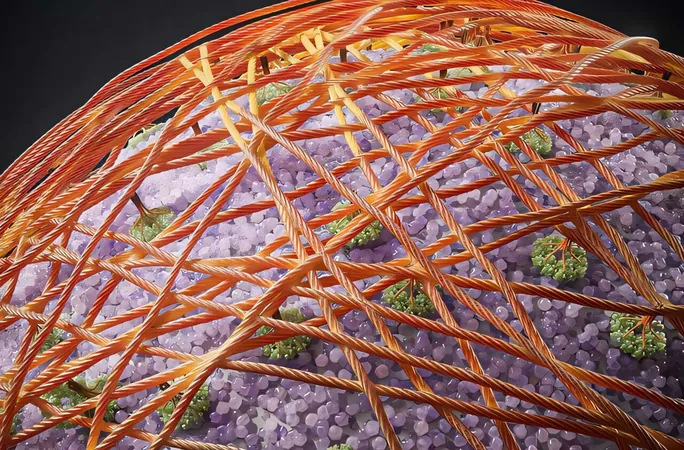
Revolutionary Breakthrough: Scientists Capture Plant Cells Building Cell Walls in Real-Time!
2025-03-21
Author: Arjun
Revolutionary Breakthrough: Scientists Capture Plant Cells Building Cell Walls in Real-Time!
In an astonishing breakthrough, researchers at Rutgers University-New Brunswick have made history by capturing the live synthesis of cellulose—the critical component of all plant cell walls—observed continuously over a 24-hour period. This pioneering study offers new insights that could revolutionize agriculture, fostering the development of sturdier plants essential for larger food production and more economical biofuel generation.
Published in the esteemed journal Science Advances, this landmark discovery unveils a dynamic, never-before-seen process that holds enormous potential for practical applications. The implications extend far beyond just basic science—enhanced cellulose understanding could lead to innovative products such as improved textiles, eco-friendly biofuels, biodegradable plastics, and advanced medical solutions.
The research reflects the collaborative efforts of three distinct laboratories at Rutgers, each bringing unique expertise from the School of Arts and Sciences, the School of Engineering, and the School of Environmental and Biological Sciences. This collective endeavor represents over six years of dedicated work unraveling the complexities of cellulose synthesis.
As Sang-Hyuk Lee, an associate professor of Physics and Astronomy and co-author of the study, points out: “This is the first direct visualization of cellulose synthesizing and self-assembling into a dense fibril network on a cell surface since Robert Hooke made his initial observations of cell walls in 1667.” Lee emphasizes that they have uncovered new insights into how basic physical processes can lead to complex structures—a revelation that challenges long-standing biological teachings.
Captured in a remarkable video, the images show protoplasts—cells stripped of their walls—from the flowering plant Arabidopsis, showcasing the chaotic yet beautiful emergence of cellulose filaments. Surprisingly, these fibers coalesce into organized structures from what begins as random molecular motions. Lee’s astonishment at this phenomenon highlights how contemporary methods can challenge and enrich our understanding of plant biology.
Fascinatingly, cellulose is the most abundant biopolymer on Earth, crucial for various industrial applications, from manufacturing paper and textiles to thickening agents in food products like yogurt. With advances like these, the quest for ecological sustainability can take a leap forward. “This discovery opens the door for future research into the genes responsible for cellulose biosynthesis, which could have far-reaching effects on plant resilience against environmental stressors and optimizing biofuel production,” explains Eric Lam, a Distinguished Professor involved in the study.
For Shishir Chundawat, a bioengineering associate professor and study co-author, this research was the fulfillment of a childhood dream. His passion for understanding plant biology—sparked by a middle school science project—has culminated in a desire to develop sustainable biofuels and biochemicals from both terrestrial plants and marine algae, demonstrating how curiosity can shape a lifetime of scientific inquiry.
Utilizing cutting-edge techniques in microscopy, the team overcame significant challenges—standard lab microscopes often provided poor, indistinct images. Instead, they employed total internal reflection fluorescence microscopy, a minimal-invasion technique capable of capturing high-resolution video without damaging the plant cells. Chundawat’s innovative approach involved tagging the cellulose filaments with fluorescent proteins, allowing for unprecedented tracking and visualization.
Lam’s team contributed by generating protoplasts with little background cellulose, enabling clear observation of newly synthesized materials under optimized conditions.
This groundbreaking work not only enhances our understanding of plant biology and cellulose synthesis but also sets the stage for future innovations. As these researchers explore the intricacies of cell-wall formation, we may soon witness the dawn of a new era in agriculture and sustainable production.
Stay tuned for more groundbreaking discoveries as science continues to unveil the marvelous complexities of the natural world!


 Brasil (PT)
Brasil (PT)
 Canada (EN)
Canada (EN)
 Chile (ES)
Chile (ES)
 Česko (CS)
Česko (CS)
 대한민국 (KO)
대한민국 (KO)
 España (ES)
España (ES)
 France (FR)
France (FR)
 Hong Kong (EN)
Hong Kong (EN)
 Italia (IT)
Italia (IT)
 日本 (JA)
日本 (JA)
 Magyarország (HU)
Magyarország (HU)
 Norge (NO)
Norge (NO)
 Polska (PL)
Polska (PL)
 Schweiz (DE)
Schweiz (DE)
 Singapore (EN)
Singapore (EN)
 Sverige (SV)
Sverige (SV)
 Suomi (FI)
Suomi (FI)
 Türkiye (TR)
Türkiye (TR)
 الإمارات العربية المتحدة (AR)
الإمارات العربية المتحدة (AR)